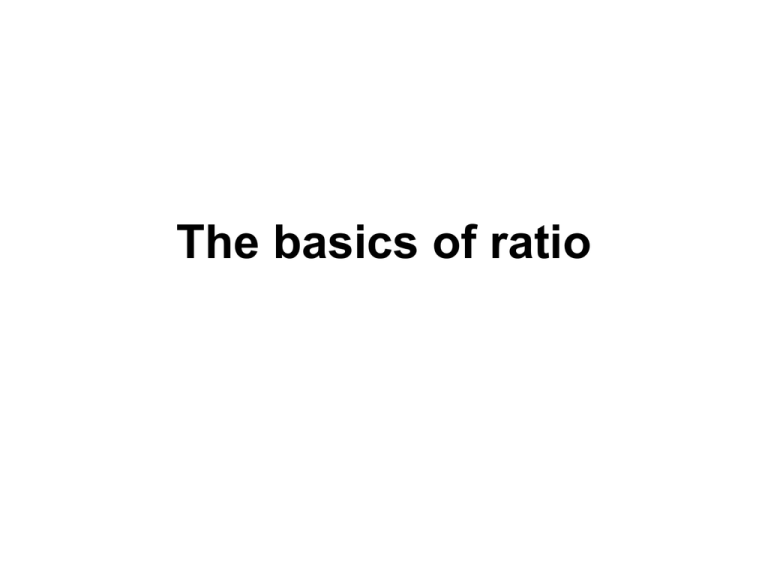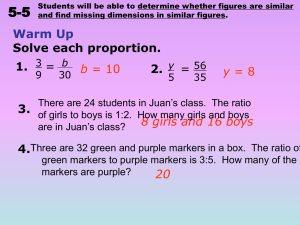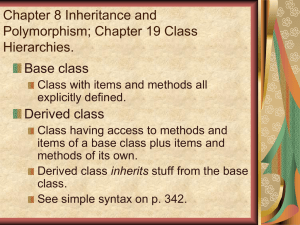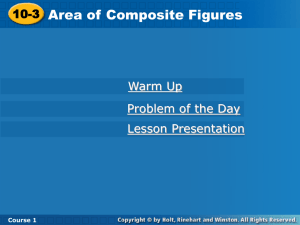The basics of ratio
advertisement

The basics of ratio • The purpose of this staff tutorial is to introduce the basic ideas of ratio and to show how ratio relates to fractions. Using this as a basis you should probably then move on to the tutorials Breakfast in Sydney and Orange and Water, where we look applications of ratio to exchange rates and proportions, respectively. • Have a look at the rectangle below. • It’s pretty easy to see that one-third of the rectangle is red and two-thirds is yellow. So there is twice as much yellow as red. So we say that yellow to red are ‘in the ratio of 2:1’. • Ratios are always represented by a colon (as in 2:1) or by the word ‘to’ (as in 2 to 1). In fact we read ‘2:1’ as ‘two to one’. • ‘Two to one’ simply means that there is twice as much of one thing as there is of the other. • Let’s have a look at another example. In the rectangle below, there is three times as much green as there is blue. So what is the ratio of green to blue? • How much more of green is there than of blue? • Because there is three times as much green as blue the ratio of green to blue is 3:1. • So when we have simple multiples like this there is no problem with finding the ratios. But here is one with a little variation. The rectangle below is 3/5 green and 2/5 red. So what is the ratio of green to red in the rectangle? • Have a crack at it. How many greens do you get for every two reds? • The ratio here is 3:2. But if you said 1.5:1, then you’re right too. Clearly for every one and a half greens you get one red. And for every 3 greens you get 2 reds. And for every 6 greens you get 4 reds, so the ratio is 6:4 as well. • You can play that game all day; because you don’t change a ratio by multiplying both sides by the same number. In fact it’s just like fractions. You know that 3 6 18 21 1.5 2 4 12 14 1 • though you would probably never put a decimal in a numerator like we have just done with 1.5. So with ratios it’s true that 3:2 = 6:4 = 18:12 = 21:14 = 1.5:1. • Ratios keep things in the same proportion. So if you have 3 apples for every 2 oranges, then you have to have 6 apples for every 4 oranges, 18 apples for every 12 oranges, 21 apples for every 14 oranges, and 1.5 apples for every 1 orange. The number of apples to oranges is always in the same proportion (ratio). • • Can you think of things in everyday life that are always in the same ratio (or nearly always in the same ratio)? How about things that are not in the same ratio? Pick out the things in the same ratio from the list below and then add your own items: i. ii. iii. iv. v. vi. vii. viii. ix. x. • • fingers per hand; cents per dollar; tries per rugby game; hours every 7 days; dollars per litre of petrol; tails per monkey; income per hour; income tax per dollar; eyes per netball team; height per tree. The items in (i), (ii), (iv), (vi), (vii) (unless you take into account overtime pay), and (ix) are always in a constant ratio. What list did you come up with? • Let’s turn that around. If I give you a ratio, say 5:3, can you divide a rectangle up into that ratio? Have a crack at that. How will you do it? • OK. For something that there are 3 of, there have to be 5 of the other thing. If we go back to coloured pieces, suppose that for every 5 lots of green there are 3 lots of red. So in 8 coloured pieces, 5 are green and 3 are red. So that gives us something like this. • But that’s not the only way the two colours can be arranged. You may well have put 8 squares in a row to make an 8 by 1 rectangle. Even then you didn’t have to colour them so that all the red was together and all the green was together. • Here are just three ways to colour a rectangle so that green to red is 5:3. • So now divide a rectangle up so that the ratio of its blue to green parts is 7:3. • And do that in about five ways. • Of course there are an infinite number of possibilities here but at the end of the day, the simplest way to do this is to first notice that 7 + 3 = 10. Then divide the rectangle up into tenths. The easiest way to do this is to make the rectangle out of 10 squares. • From here, 7 of the squares have to be blue and 3 have to be green. • Now that you have mastered that, how about dividing a rectangle up so that the ratio of its blue to red parts is 2:7? • We haven’t had a ratio where the second part was bigger than the first part but that shouldn’t worry you. Exactly the same principle applies. • It’s getting a bit boring with the coloured rectangles. Let’s apply ratios to fruit. Suppose we want to divide some fruit up so that the ratio of the fruit that I get to the fruit that you get is 2:7. Then we apply exactly the same principle to fruit as we did to area. • First think about the fact that 2 + 7 = 9. Then arrange for every 9 pieces of fruit that I get 2 and you get 7. • Actually, when you think about it, what has happened here is that for every 9 pieces of fruit I get 2/9 and you get 7/9. So we don’t even have to stick to whole pieces of fruit. • So if you give me 1/6 of a pizza and you take 5/6, then you have split the pizza from me to you in the ratio of 1:5. • And if you’ve divide $100 between me and you in the ratio of 9:1, then you’ve divided it up into tenths – that’s lots of $10. And I have got 9/10 (that’s very generous of you, thanks) and you have got 1/10. So I take away $90 and you take away $10. • Suppose that the exchange rate today for Wellandian dollars is 50, in other words for every $1 New Zealand you get $50 Wellandian, then we have a ratio problem to find the number of Wellandian dollars you can get for $3 New Zealand. This is because the exchange rate is a ratio of 1:50. For the first $1 New Zealand you get $50 Wellandian; for the second $1 New Zealand you get $50 Wellandian; and for the third $1 New Zealand you get $50 Wellandian. So for $3 New Zealand you get $150 Wellandian. You see that the ratio of 1:50 is the same as 3:150. And that’s the way to calculate how to exchange from one currency to the next • But just when you were feeling confident about this ratio business, the Principal comes in. Is it possible to divide that $100 we were talking about a little while ago in the ratio of 4:3:3 for me to the Principal to you? • But why is that hard? Think about what we did with the simpler ratios. 4 + 3 + 3 = 10. That suggests that we break everything up into tenths. So I get 4/10, the Principal gets 3/10 and you get 3/10 too. Ok, I’m off with $40, the Principal gets $30 and you get $30 too. • How about dividing a rectangle up into red to white to blue in the ratio of 4:5:1? • Or how about dividing the angles in a triangle into the ratio 5:6:7? (Bear in mind that there are 180 degrees in a triangle.) • What fraction of the fruit do we all get if you divide the fruit between you, me and your brother in the ratio of 3:2:1? • And if in a basketball game you get 2/9 of the points while I get 3/9 of the points and your sister gets the rest, in what ratio did we divide the points? • Please email us at derek@nzmaths.co.nz for any correspondence related to this workshop.
















